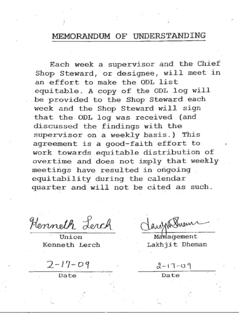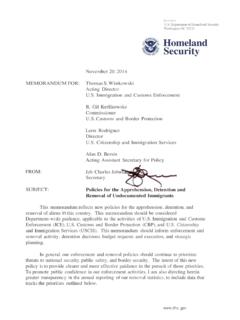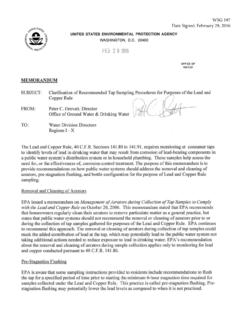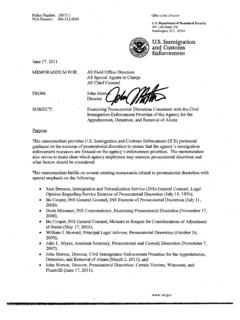Transcription of Internal Revenue Service Memorandum
1 Office of Chief CounselInternal Revenue ServiceMemorandumNumber: 201504011 Release Date: 1/23/2015CC:ITA:6 LFNolanIIPOSTS-125750-13 , , , , , : December 10, 2014to: Matthew A. HoutsmaAssociate Area Counsel (Small Business/Self-Employed)CC:SB:5:Den:2from : W. Thomas McElroy, TechnicianReviewerOffice of Associate Chief Counsel (Income Tax & Accounting)CC:ITA:6subject: Taxpayers Trafficking in a Schedule I or Schedule II Controlled Substance --Capitalization of Inventoriable CostsThis adviceresponds to your request for assistance. This advice may not be used or cited as (1)How does a taxpayer trafficking in a Schedule I or Schedule II controlled substance determine cost of goods sold ( COGS ) for the purposes of 280E of the Internal Revenue Code ( Code )?(2)May Examination or Appeals require a taxpayer trafficking in a Schedule I or Schedule II controlled substance to change to an inventory method for that controlled substance when the taxpayer currently deducts otherwise inventoriable costs from gross income?
2 CONCLUSION(1)A taxpayer trafficking in a Schedule I or Schedule II controlled substance determines COGS using the applicable inventory-costing regulations under 471 as they existed when 280E was (2)Yes, unless the taxpayer is properly using a non-inventory method to account for the Schedule I or Schedule II controlled substance pursuant to the Code, Regulations, or other published the Comprehensive Drug Abuse Prevention and Control Act of 1970, 21 801 971 (1970), ( Controlled Substances Act or CSA ), Congress created a regime to curtail the unlawful manufacture, distribution, and abuse of dangerous drugs ( controlled substances ). Congress assigned each controlled substance to one of five lists (Schedule I through Schedule V). See 812 of the CSA. Schedule I includes: (a) opiates; (b) opium derivatives ( , heroin; morphine); and (c)hallucinogenic substances ( , LSD; marihuana (a/k/a marijuana); mescaline; peyote).
3 Though a medical marijuana business is illegal under federal law, it remains obligated to pay federal income tax on its taxable income because 61(a) does not differentiate between income derived from legal sources and income derived from illegal sources. See, , James v. United States, 366 213, 218 (1961). Under the Sixteenth Amendment of the United States Constitution ( Sixteenth Amendment ), Congress is authorized to lay and collect taxes on income. In a series of cases, the United States Supreme Court has held that income in the context of a reseller or producer means gross income, not gross receipts. In other words, Congress may not tax the return of capital. See, , Doyle v Mitchell Bros. Co., 247 179, 185 ( As was said in Stratton s Independence v. Howbert, [citation omitted], Income may be defined as the gain derived from capital, from labor, or from both combined. ); New Colonial Ice Co. v.
4 Helvering, 292 435, 440 (1934) ( The power to tax income like that of the new corporation is plain and extends to the gross income. Whether and to what extent deductions shall be allowed depends upon legislative grace; and only as there is clear provision therefor can any particular deduction be allowed. ).Section 61(a) defines gross income broadly using 15 examples of items that are includible in gross income. Consistent with the Sixteenth Amendment, 61(a)(3) provides that gross income includes net gains derived from dealings in property, which includes controlled substances produced or acquired for resale. Gains derived from dealings in property means gross receipts less COGS, which is the term given to the adjusted basis of merchandise sold during the taxable year. Section (a) of the Income Tax Regulations. See also 1001(a); 1011(a); 1012(a). As the Tax Court explained in Reading v. Commissioner, 70 730, 733 (1978), [t]he cost of goods sold concept embraces expenditures necessary to acquire, construct or extract a physical product which is to be sold; the seller can have no gain until he recovers the economic investment that he has made directly in the actual item sold.
5 A taxpayer derives COGS using the following formula: beginning inventories plus current-year production costs (in the case of a producer) or current-year purchases (in the case of a reseller) less ending inventories. In general, the taxpayer first determines gross income by subtracting COGS from gross receipts, and then determines taxable income by POSTS-125750-133subtracting all ordinary and necessary business expenses ( , 162(a)) from gross 1981, the Tax Court allowed an illegal business to recover the cost of the controlled substances ( , amphetamines; cocaine; marijuana) obtained on consignment and also to claim certain business deductions (a portion of the rent he paid on his apartment which was his sole place of business, the cost of a small scale, packaging expenses, telephone expenses, and automobile expenses). See Jeffrey Edmondson v. Commissioner, Memo. 1982, Congress enacted 280E, which reverses the holding in Edmondsonas it relates to deductions other than the cost of the controlled substances.
6 Section 280E reads as follows:No deduction or credit shall be allowed for any amount paid or incurred during the taxable year in carrying on any trade or business if such trade or business (or the activities which comprise such trade or business) consists of trafficking in controlled substances (within the meaning of schedule I and II of the Controlled Substances Act) which is prohibited by Federal law or the law of any State in which such trade or business is Explanation of Provision, the Senate Report reads as follows:All deductions and credits for amounts paid or incurred in the illegal trafficking in drugs listed in the Controlled Substances Act are disallowed. To preclude possible challenges on constitutional grounds, the adjustment to gross receipts with respect to effective costs of goods sold is not affected by this provision of the REP. NO. 97-494 (Vol. I), at 309 (1982). The Senate bill was adopted in conference.
7 CONF. REP. NO. 97-760, at 598 (1982), 1982-2 enacting 280E, Congress exercised its authority to withhold the legislative grace mentioned in New Colonial Ice Co., supra. It is important to understand that 280E even disallows a deduction for expenses that are not illegal per se ( , salaries; rent; telephone). Thus, 280E has a greater reach than 162(c), which disallows a deduction for specified illegal payments ( , bribes; kickbacks).When 280E was enacted, taxpayers using an inventory method were subject to the inventory-costing regulations under 471. Specifically, resellers were subject to (b), and producers were subject to (c) and ( full-absorption regulations ).POSTS-125750-134 Four years after enacting 280E, Congress enacted the Tax Reform Act of 1986, which added the uniformcapitalization rules of 263A to the Code. Under 263A(a), resellers and producers of merchandise are required to treat as inventoriable costs the direct costs of property purchased or produced, respectively, and a proper share of those indirect costs that are allocable (in whole or in part) to that property.
8 Flush language at the end of 263A(a)(2) provides, Any cost which (but for this subsection) could not be taken into account in computing taxable income for any taxable year shall not be treated as a cost described in this paragraph. The flush language at the end of 263A(a)(2) was added by 1008(b)(1) of the Technical and Miscellaneous Revenue Act of 1988 ( TAMRA )1( 100-647), reprinted in1988 4621, as a retroactive, technical correction. Under Explanation of Provision, the Senate Report reads as follows:The bill also clarifies that a cost is subject to capitalization under this provision only to the extent it would otherwise be taken into account in computing taxable income for any taxable year. Thus, for example, the portion of a taxpayer s interest expense that is allocable to personal loans, and hence is disallowed under section 163(h), may not be included in a capital or inventory account and recovered through depreciation or amortization deductions, as a cost of sales, or in any other Rep.
9 No. 100-445, at 104 (1988). The Tax Court has tried a few cases involving taxpayers that sell medical marijuana. In the seminal case in this area, the Tax Court held thatthe taxpayer trafficked in medical marijuana, which is a Schedule I controlled substance, and that 280E disallows all deductions attributable to that trade or business. The Tax Court also held, however, that 280E does not disallow the deductions attributable to the taxpayer s separate and lawful trade or business. Californians Helping to Alleviate Medical Problems, Inc., v. Commissioner, 128 173 (2007) ( CHAMP ). In CHAMP, the government conceded that 280E does not prohibit a taxpayer from claiming COGS. 178, n. 4. In other cases involving nonmedical marijuana or other Schedule I controlled substances, the Tax Court recognized that 280E does not disallow adjustments to gross receipts for COGS. See, , Peyton v. Commissioner, Memo.
10 2003-146; Franklin v. Commissioner, Memo. 1993-184; McHan v. Commissioner, Memo. literally, 280E severely penalizes taxpayers that traffic in a Schedule I or Schedule II controlled substance but don t use an inventory method for the controlled substance. When required to use an inventory method, a taxpayer also is required to use an accrual method for purchases and sales of merchandise. See ; 1 TAMRA began as the Technical Corrections Act of 1988 (S. 2238) and the Miscellaneous Revenue Bill of 1988 ( 4333).POSTS-125750-1351(c)(2)(i). But see (b).2 Thus, the taxpayer will capitalize inventoriable costs when incurred and will remove these costs from inventory when units of merchandise are sold. Stated differently, the taxpayer will compute COGS as an adjustment to gross receipts. On the other hand, when not required to use an inventory method, a taxpayer might be permitted to use the cash method.
















